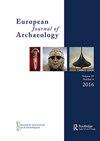The Power of Relics: The Curation of Human Bone in British Bronze Age Burials
IF 1.4
2区 历史学
0 ARCHAEOLOGY
引用次数: 3
Abstract
In this article, the authors examine radiocarbon, histo-taphonomic, and contextual evidence for the deliberate curation, manipulation, and redeposition of human bone in British Bronze Age mortuary contexts. New radiocarbon dates and histological analyses are combined with existing data to explore the processes and practices that resulted in the incorporation of ‘relic’ fragments of bone in later graves, including evidence for the deliberate re-opening of previous burials and for funerary treatments such as excarnation and mummification. In some cases, fragments of human bone were curated outside the mortuary context. The authors consider what the treatment of human remains reveals about mortuary complexity in the Bronze Age, about relations between the living and the dead, and about attitudes to the body and concepts of the self.文物的力量:英国青铜器时代墓葬中人骨的管理
在这篇文章中,作者研究了放射性碳、历史地语学和背景证据,以证明在英国青铜时代的太平间中,人类骨骼的故意管理、操纵和重新沉积。新的放射性碳测年和组织学分析与现有数据相结合,探索导致后来的坟墓中纳入“遗物”骨头碎片的过程和做法,包括故意重新打开以前的墓葬和丧葬处理(如石棺和木乃伊化)的证据。在某些情况下,人类骨骼的碎片是在太平间之外的环境中保存的。作者认为,人类遗骸的处理方式揭示了青铜器时代太平间的复杂性,生者与死者之间的关系,以及对身体和自我概念的态度。
本文章由计算机程序翻译,如有差异,请以英文原文为准。
求助全文
约1分钟内获得全文
求助全文
来源期刊

European Journal of Archaeology
ARCHAEOLOGY-
CiteScore
3.40
自引率
6.70%
发文量
58
期刊介绍:
The publication organ of the European Association of Archaeologists, the European Journal of Archaeology seeks to promote open debate amongst archaeologists committed to a new idea of Europe in which there is more communication across national frontiers and more interest in interpretation. The journal accepts not only new empirical data and new interpretations of the past but also encourages debate about the role archaeology plays in society, how it should be organized in a changing Europe, and the ethics of archaeological practice. All periods are covered; papers, review articles, interviews and short "debate" pieces are all sought. Whilst English is the primary language of publication in the EJA, papers submitted in French or German will be given equal consideration.
 求助内容:
求助内容: 应助结果提醒方式:
应助结果提醒方式:


